The Feline Atopic Dermatitis Treatment Market is estimated to be valued at USD 5.7 billion in 2025 and is projected to reach USD 8.9 billion by 2035, registering a compound annual growth rate (CAGR) of 4.5% over the forecast period.
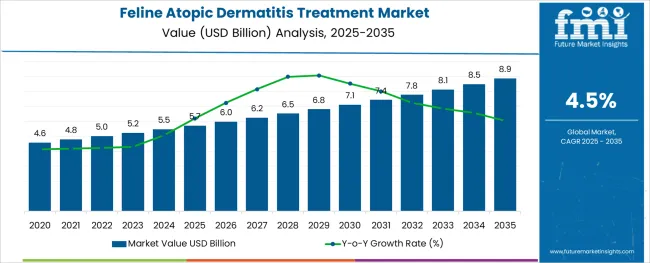
The feline atopic dermatitis treatment market is expanding steadily due to the increasing awareness of skin allergies and improved veterinary care standards for pets. Veterinary professionals have emphasized the importance of effective and safe treatments to manage chronic dermatological conditions in cats. Growth in pet ownership and the humanization of pets have led to higher demand for specialized medications that address allergic reactions and skin inflammation.
Advances in drug formulations and administration methods have improved treatment compliance and outcomes. Furthermore, the increasing number of veterinary clinics and pet pharmacies has enhanced access to these medications.
Market expansion is expected to be supported by ongoing research into novel therapies and a growing focus on pet wellness. The market is primarily driven by the Corticosteroids drug class, Oral route of administration, and Veterinary Pharmacies as the preferred distribution channel.
The market is segmented by Drug Class, Route of Administration, and Distribution Channel and region. By Drug Class, the market is divided into Corticosteroids, Antihistamines, and Antibiotics. In terms of Route of Administration, the market is classified into Oral, Topical, and Injectable. Based on Distribution Channel, the market is segmented into Veterinary Pharmacies, Retail Pharmacies, and Online Pharmacies. Regionally, the market is classified into North America, Latin America, Western Europe, Eastern Europe, Balkan & Baltic Countries, Russia & Belarus, Central Asia, East Asia, South Asia & Pacific, and the Middle East & Africa.
The market is segmented by Drug Class, Route of Administration, and Distribution Channel and region. By Drug Class, the market is divided into Corticosteroids, Antihistamines, and Antibiotics. In terms of Route of Administration, the market is classified into Oral, Topical, and Injectable. Based on Distribution Channel, the market is segmented into Veterinary Pharmacies, Retail Pharmacies, and Online Pharmacies. Regionally, the market is classified into North America, Latin America, Western Europe, Eastern Europe, Balkan & Baltic Countries, Russia & Belarus, Central Asia, East Asia, South Asia & Pacific, and the Middle East & Africa.
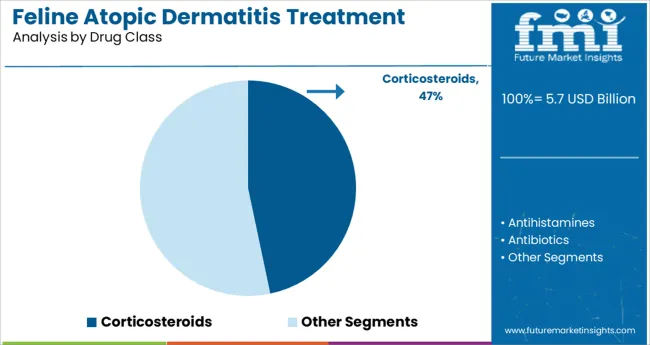
The Corticosteroids segment is projected to hold 46.7% of the market revenue in 2025, maintaining its dominance among drug classes. These drugs are favored for their potent anti-inflammatory and immunosuppressive effects, which help reduce itching and skin inflammation quickly in feline patients.
Veterinary practitioners have relied on corticosteroids due to their rapid onset of action and proven efficacy in managing atopic dermatitis symptoms. Despite concerns about long-term side effects, corticosteroids continue to be the first-line treatment in many cases, supported by dosage optimization and monitoring protocols.
The segment’s growth is further supported by increasing veterinary education and pet owner awareness about managing chronic skin conditions. As treatment protocols evolve, corticosteroids are expected to remain a cornerstone therapy in feline atopic dermatitis management.

The Oral segment is anticipated to account for 52.3% of the market revenue in 2025, positioning it as the leading route of administration. Oral treatments are preferred for their convenience, ease of dosing, and suitability for long-term management of chronic conditions like atopic dermatitis.
Cats and their owners benefit from oral medications that can be administered at home, improving adherence to prescribed treatment plans. The development of palatable formulations and precise dosing options has further encouraged the use of oral drugs.
Additionally, oral corticosteroids and other systemic therapies have demonstrated consistent effectiveness in clinical practice. As pet owners seek manageable and non-invasive treatment options, the oral administration route is expected to continue leading the market.
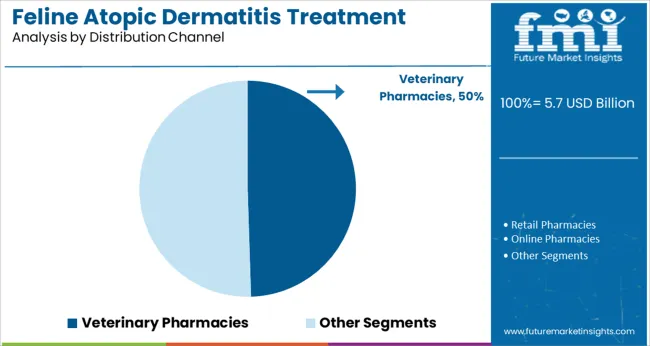
The Veterinary Pharmacies segment is projected to represent 49.5% of the market revenue in 2025, securing its position as the primary distribution channel. This segment has grown due to the trust pet owners place in specialized pharmacies for obtaining prescription medications and professional advice.
Veterinary pharmacies offer targeted products and knowledgeable staff capable of guiding pet owners on proper medication use and managing side effects. They also provide a convenient point of access within or near veterinary clinics, streamlining the treatment process.
Increasing numbers of veterinary pharmacies and expansion into online pharmacy services have improved availability and convenience. With rising pet healthcare spending and focus on specialized treatments, veterinary pharmacies are expected to maintain their dominant role in the distribution of feline atopic dermatitis therapies.
One of the primary factors driving the growth in the market is rising adoption of companion animals such as dogs and cats across the globe. According to the National Kitten Coalition statistics, around 1.3 million cats are adopted every year as pets across the globe.
With rising adoption of cats, prevalence of skin allergies and other diseases in feline will improve the demand for feline atopic dermatitis treatments. Besides this, increasing number of veterinarians in developed regions such as North America and Europe will further spur the growth in the market.
With increasing number of pet adoption across the globe, prevalence of several animal diseases is also surging. Every year over 7.6 million companion animals such as cats and dogs enter shelter across the globe. Among which, over 3.4 million felines are adopted, as per the National Kitten Coalition.
However, lack of novel treatment in emerging economies such as Brazil, Argentina, India, and others might limit the growth in the market. Due to the lack of treatment, the chance of reoccurrence of atopic dermatitis is high. This might hamper the feline atopic dermatitis treatment market.
Another factor hampering the demand in the market is treatment cost of feline atopic dermatitis treatment. As per the study, the cost of this treatment is generally high, which might affect the sales in Latin America and Middle East & Africa.
Additionally, long-term side-effects of corticosteroids might limit the sales of oral treatment. This is expected to hinder the growth in the market.
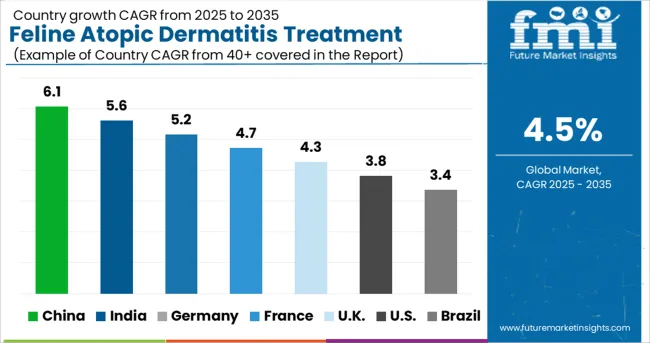
Asia Pacific feline atopic dermatitis treatment market is anticipated to witness modest growth between 2025 and 2035, opines Future Market Insights (FMI). Asia Pacific is considered to be the emerging feline atopic dermatitis market owing to the rising pet ownership of cats and dogs in India, China, and Japan.
As per FMI, India is expected to spearhead the growth in Asia Pacific market over the forecast period. This is due to the increasing number of veterinarians in the country coupled with rising adoption of cats. Moreover, rise in the number of research organizations to develop novel medicines and treatment procedures in China will boost the market.
Further, greater penetration of leading players in India and adequate availability of treatment for pet animals will improve the demand in Asia Pacific market over the upcoming decade.
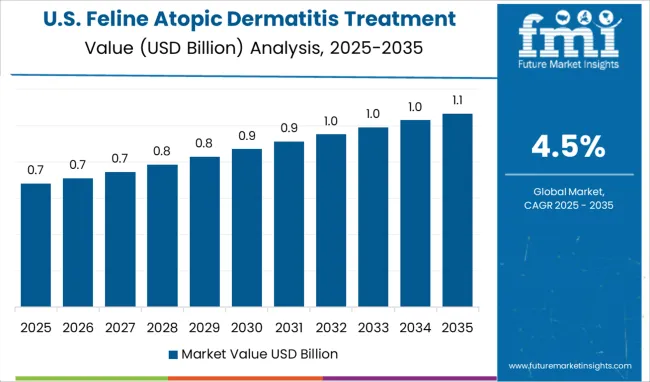
As per FMI, the USA is expected to account for significant share in North America feline atopic dermatitis treatment market. Around 5.5 million pets were adopted in 2024 across the USA, according to the Pet Adoption Statistics. Out of which, there were 1.1 million cats and the number is projected to increase over the coming decade.
With growth in the number of pet adoption, prevalence of skin treatment among feline is also surging. This is expected to create lucrative growth opportunities for feline atopic dermatitis treatment market in North America.
Further, availability of reimbursement policies, growing number of veterinarians, and early adoption of novel medication and treatment in the USA will propel the demand in the North America market.
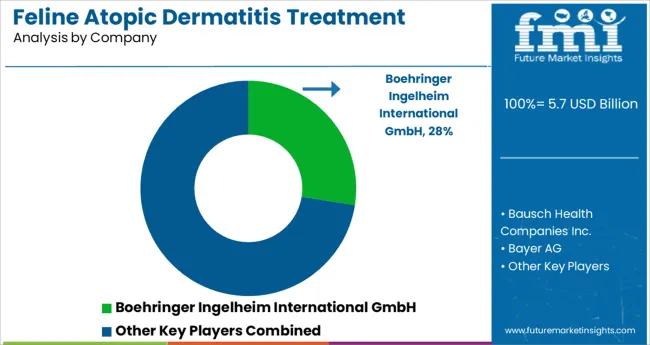
Some of the leading manufacturers of feline atopic dermatitis treatment include Bayer AG, Pfizer Inc., Boehringer Ingelheim International GmbH Novartis AG, Eli Lily Company, Sanofi, Bristol-Myers Squibb Company, and Bausch Health Companies Inc. among others.
Key players in the feline atopic dermatitis treatment market are relying on merges and collaborative agreements to increase their revenue. They are also investing in research and development activities to develop novel treatments and medicines to expand their product portfolio.
| Report Attribute | Details |
|---|---|
| Growth Rate | CAGR of 4.5% from 2025 to 2035 |
| Estimated Market Size (2025) | ~USD 5 billion |
| Projected Market Size (2035) | ~USD 7 billion |
| Base Year for Estimation | 2024 |
| Historical Data | 2020 to 2024 |
| Forecast Period | 2025 to 2035 |
| Quantitative Units | Revenue in million and CAGR from 2025 to 2035 |
| Report Coverage | Revenue Forecast, Volume Forecast, Company Ranking, Competitive Landscape, Growth Factors, Trends and Pricing Analysis |
| Segments Covered |
Drug Class, Route of Administration, Distribution Channel, Region |
| Regions Covered | North America; Latin America; Western Europe; Eastern Europe; Asia Pacific; Japan; Middle East and Africa
|
| Key Countries Profiled | USA, Canada, Brazil, Argentina, Germany, UK, France, Spain, Italy, Nordics, BENELUX, Australia & New Zealand, China, India, ASEAN, GCC, South Africa |
| Key Companies Profiled | Bausch Health Companies Inc.; Bayer AG; Pfizer Inc.; Novartis AG; Eli Lily Company; Sanofi; Bristol-Myers Squibb Company; Boehringer Ingelheim International GmbH
|
| Customization | Available Upon Request |
The global feline atopic dermatitis treatment market is estimated to be valued at USD 5.7 billion in 2025.
It is projected to reach USD 8.9 billion by 2035.
The market is expected to grow at a 4.5% CAGR between 2025 and 2035.
The key product types are corticosteroids, antihistamines and antibiotics.
oral segment is expected to dominate with a 52.3% industry share in 2025.






Our Research Products

The "Full Research Suite" delivers actionable market intel, deep dives on markets or technologies, so clients act faster, cut risk, and unlock growth.

The Leaderboard benchmarks and ranks top vendors, classifying them as Established Leaders, Leading Challengers, or Disruptors & Challengers.

Locates where complements amplify value and substitutes erode it, forecasting net impact by horizon

We deliver granular, decision-grade intel: market sizing, 5-year forecasts, pricing, adoption, usage, revenue, and operational KPIs—plus competitor tracking, regulation, and value chains—across 60 countries broadly.

Spot the shifts before they hit your P&L. We track inflection points, adoption curves, pricing moves, and ecosystem plays to show where demand is heading, why it is changing, and what to do next across high-growth markets and disruptive tech

Real-time reads of user behavior. We track shifting priorities, perceptions of today’s and next-gen services, and provider experience, then pace how fast tech moves from trial to adoption, blending buyer, consumer, and channel inputs with social signals (#WhySwitch, #UX).

Partner with our analyst team to build a custom report designed around your business priorities. From analysing market trends to assessing competitors or crafting bespoke datasets, we tailor insights to your needs.
Supplier Intelligence
Discovery & Profiling
Capacity & Footprint
Performance & Risk
Compliance & Governance
Commercial Readiness
Who Supplies Whom
Scorecards & Shortlists
Playbooks & Docs
Category Intelligence
Definition & Scope
Demand & Use Cases
Cost Drivers
Market Structure
Supply Chain Map
Trade & Policy
Operating Norms
Deliverables
Buyer Intelligence
Account Basics
Spend & Scope
Procurement Model
Vendor Requirements
Terms & Policies
Entry Strategy
Pain Points & Triggers
Outputs
Pricing Analysis
Benchmarks
Trends
Should-Cost
Indexation
Landed Cost
Commercial Terms
Deliverables
Brand Analysis
Positioning & Value Prop
Share & Presence
Customer Evidence
Go-to-Market
Digital & Reputation
Compliance & Trust
KPIs & Gaps
Outputs
Full Research Suite comprises of:
Market outlook & trends analysis
Interviews & case studies
Strategic recommendations
Vendor profiles & capabilities analysis
5-year forecasts
8 regions and 60+ country-level data splits
Market segment data splits
12 months of continuous data updates
DELIVERED AS:
PDF EXCEL ONLINE
Atopic Dermatitis Treatment Market Analysis Size, Share, and Forecast Outlook 2025 to 2035
Canine Atopic Dermatitis Treatment Market Growth – Demand & Forecast 2024-2034
Treatment-Resistant Hypertension Management Market Size and Share Forecast Outlook 2025 to 2035
Treatment-Resistant Depression Treatment Market Size and Share Forecast Outlook 2025 to 2035
Treatment Pumps Market Insights Growth & Demand Forecast 2025 to 2035
Pretreatment Coatings Market Size and Share Forecast Outlook 2025 to 2035
Air Treatment Ozone Generator Market Size and Share Forecast Outlook 2025 to 2035
CNS Treatment and Therapy Market Insights - Trends & Growth Forecast 2025 to 2035
Seed Treatment Materials Market Size and Share Forecast Outlook 2025 to 2035
Acne Treatment Solutions Market Size and Share Forecast Outlook 2025 to 2035
Scar Treatment Market Overview - Growth & Demand Forecast 2025 to 2035
Soil Treatment Chemicals Market
Water Treatment System Market Size and Share Forecast Outlook 2025 to 2035
Water Treatment Chemical Market Size and Share Forecast Outlook 2025 to 2035
Algae Treatment Chemical Market Forecast and Outlook 2025 to 2035
Water Treatment Market Size and Share Forecast Outlook 2025 to 2035
Water Treatment Ozone Generator Market Size and Share Forecast Outlook 2025 to 2035
Water Treatment Equipment Market Size and Share Forecast Outlook 2025 to 2035
Burns Treatment Market Overview – Growth, Demand & Forecast 2025 to 2035
CRBSI Treatment Market Insights - Growth, Trends & Forecast 2025 to 2035

Thank you!
You will receive an email from our Business Development Manager. Please be sure to check your SPAM/JUNK folder too.
Chat With
MaRIA